“Yoga was a real revelation to me, although at first I didn’t believe it—I thought it was a waste of time,” Kulenovic recalls. “Then, the movement and coordinated breathing began to work and only a month after starting, I noticed quite a few benefits, including fewer hot flashes and more energy. It’s become my indispensable booster.”
Now at age 57, she’s through the difficult perimenopause phase—which started in her late 30s—and wishes more women knew about yoga’s effects, because it’s been so empowering for her.
“Even now, our society does not adequately prepare us for the challenges of the menopausal transition,” she says. “With this practice, I’ve regained my self-confidence.”
Research backs up what Kulenovic discovered: For example, a December 2017 research review in Maturitas found that yoga is effective and safe for reducing symptoms of menopause, including fatigue, joint pain, hot flashes, poor sleep, and mood changes. A July 2021 study in The Journal of Obstetrics and Gynecology also found significant improvements in these symptoms from yoga, especially compared to more modest benefits from a walking routine.
That doesn’t mean yoga alone can help you ditch hormone therapy if that’s benefiting you, or that you won’t need other types of support and activity—looking at you, strength training—as you navigate the sometimes choppy waters of perimenopause and menopause. But it can be a strong complement to other healthy changes, says Savonn Wyland, RYT, yoga teacher and owner of Sellwood Yoga in Portland, Oregon. At 55, she’s seen the benefits of yoga for menopause firsthand.
“There’s a feeling of being on a rollercoaster for many people, because so much is changing physically and emotionally,” she says. “Yoga is really helpful for calming the nervous system and helping you pay attention to how you’re feeling.”
Here’s a look at what the research and experts say about the ways yoga can be helpful, along with some poses to get you started.
In This Article
-
01
-
02
Benefits of yoga for menopause that’ll make you want to roll out your mat
1. It eases hot flashes
Despite the fun-sounding superpower description, hot flashes are one of the top complaints about perimenopause and menopause, affecting about 75 percent of people going through it, according to the North American Menopause Society.
Although the cause isn’t fully understood, they’re believed to be related to changes in the hypothalamus, the part of the brain that regulates body temperature. The frequency and intensity of these flashes vary from person to person, but they can be debilitating, especially since they tend to mess with your sleep.
“For me, the hot flashes became more and more frequent, and with each new stressor at work, they’d last longer,” Kulenovic says. “That led to feeling anxious overall, and the ripple effect with that created problems with digestion, then weight gain. I’ve always been a positive person, but I couldn’t recognize myself during this period.”
The type of mindful, focused breathing that yoga employs eased all of that, she says. Even when not in a yoga class, she used the breathing techniques to slow down and alleviate stress, which greatly reduced the frequency and duration of the hot flashes.
The combo of controlled movement and deep breathing is what makes yoga unique compared to doing simple stretches, walking, or other exercise. It’s this combination that’s been shown to soothe the nervous system, says Rachel Hirsch, RYT, yoga teacher and founder of Empowered Yoga in Los Angeles.
“We know that stress is a trigger for increased menopause symptoms, including hot flashes, so by reducing that stress, it can help ease those issues,” she adds.
Research supports that perspective: An August 2014 study in Menopause found that after 10 weeks of a yoga practice, participants had a 66 percent reduction in hot flashes. A July 2007 study in Maturitas, also done over 10 weeks, noted significant improvement in hot flash frequency and severity.
2. It prevents sleep disruption and fatigue
Although it’s possible to have fatigue without sleep problems, they’re often related because poor sleep quality can lead to feeling depleted during the day. It’s a ripple effect that 52-year-old Stacey Degen remembers well.
“In my mid-40s, I started experiencing restless sleep and agitation at night, then fatigue during the day, and I chalked it up to stress,” she says. “At first, I thought I could just exercise harder. I’ve always enjoyed physically demanding workouts, like really intense endurance sports. But I’d do those and be completely exhausted. Exercising like that was making it worse.”
As an acupuncturist, Degen is well versed in knowledge about the way energy moves through the body, and the value of a more restorative practice. She turned to styles of yoga that emphasize slow movement, rest, and deep breathwork—such as yin yoga and yoga nidra.
“My focus was on cultivating more calm and creating a greater sense of balance,” she says. “That helped my sleep and energy, but it also had other effects I didn’t expect, like increasing my libido and helping my mood.”
Research on the effects of sleep for menopausal women shows that Degen isn’t alone—in a July 2022 trial in Nursing & Health Sciences, yoga significantly improved sleep quality in perimenopausal and postmenopausal people. And, a February 2012 trial, detailed in Menopause, found similar effects in reducing insomnia for those doing yoga, compared to participants who did only stretching exercises.
3. It hampers mood shifts
Although many women might expect hot flashes or fatigue as part of menopause, changes in emotional regulation might take them by surprise.
“This is a period of intense vulnerability, when there can be dramatic emotional shifts,” according to Anna Cabeca, DO, a Dallas, Texas-based OB/GYN and author of MenuPause, a dietary guide to perimenopause and menopause. “If there’s been previous trauma or stress, it’s like living inside a pressure cooker and you don’t know when it’s going to blow up.”
An October 2018 study in Obstetrics and Gynecology Clinics of North America noted a two- to five-fold increased risk for major depressive disorder during perimenopause compared to menopause itself. Researchers added that in addition to hormonal changes, psychosocial factors were also dominant, such as life events, social support, socioeconomic status, and stress.
While hormones do play a major role in emotional changes, there are additional factors at play, she says. Most notably, this is a time of life with significant shifts, like children growing up and leaving home and older parents needing more assistance, Cabeca says. Sleep issues, weight gain, reduced libido, and fatigue can all stack on top of this and reduce resilience. Think of yoga as the release valve on that pressure cooker.
“While all exercise is good for physical and mental health, yoga seems to have a slight edge, because it addresses both in a deliberate way,” says Kate Ingram, RYT, RDN, yoga teacher and registered dietitian nutritionist who specializes in healthy aging.
An April 2019 study in the International Journal of Behavioral Nutrition and Physical Activity found that those who practiced yoga had better perceived mental health and lower depression rates. Another study, in a July-December 2011 issue of the International Journal of Yoga, found that yoga can reduce stress, anxiety, and depression, as well as alleviate chronic pain.
“While yoga certainly can’t replace medication for depression or anxiety, it may be a helpful complementary practice,” says Ingram.
“Perimenopause and menopause shouldn’t be seen as a time of loss, it’s a time for acceptance that your body is changing.” —Savonn Wyland, RYT
4. It improves focus
Another issue that might feel unexpected with menopause is the “brain fog” that can leave you feeling distracted and unfocused, and that can be hugely frustrating, Kulenovic says.
“Constantly, I felt foggy in my brain, my memory was at zero and I could hardly focus,” she recalls. “It made me feel insecure and caused my work productivity to suffer.”
Yoga provided benefits here as well, she says, because she trained herself to pay attention in new ways.
“Although I still had difficulties with memory and confusion, I began to notice that my concentration was improving,” she says.
That’s because yoga may cause actual brain changes, research suggests. A December 2019 review of 11 studies on yoga, published in Brain Plasticity, showed that yoga can affect the structure and function of certain parts of the brain, including the hippocampus, amygdala, and prefrontal cortex—which are all involved with memory, information process, problem solving, and emotional regulation. Those researchers suggested yoga may even be beneficial for mitigating age-related decline in brain function overall.
5. It limits feelings of isolation
Maybe you’re not sleeping well, your anger flares up and then collapses into sadness, your brain fog and distraction makes it tough to navigate everyday tasks, and on top of all that, the hot flashes leave you sweaty and exhausted. What could make these symptoms worse? Feeling like you’re dealing with them alone.
Although yoga classes may not include conversations about what you’re going through, they can definitely bolster a sense of community, Wyland says. Her classes often have women in their 40s and 50s who create connections with each other and provide a feeling of sisterhood at a time when self-confidence may be lacking.
“When you’re around people going through an experience similar to your own, it can be a relief,” she says. “You feel more seen and heard, there’s a sense of belonging that’s crucial because this is not an easy time. Perimenopause and menopause shouldn’t be seen as a time of loss, it’s a time for acceptance that your body is changing. Having support for that natural process can bring lightness, and most of all, deep feelings of self-compassion.”
The best yoga poses for menopause
1. Legs up the wall pose (Viparita Karani)
Legs up the wall pose “helps with calm, soothes the nervous system to improve sleep and reduce hot flashes,” Wyland says.
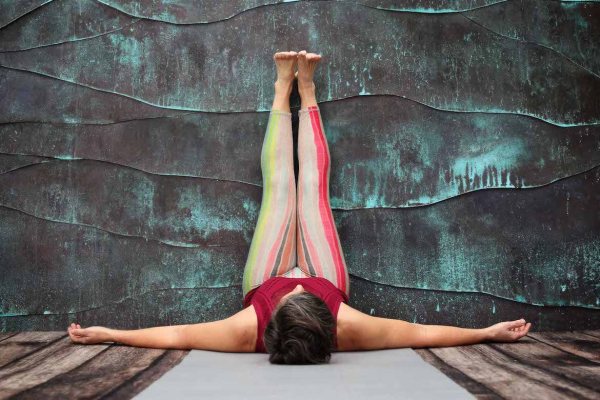
- Place your yoga mat perpendicular to a wall and place a cushion right up against the wall.
- Sit with your left side against the wall.
- Gently turn your body to the left and carefully swing your legs up the wall.
- Lower your back to the floor and lie down. Rest your shoulders and head on the floor.
- Let your arms relax out to your sides at an angle that feels comfortable for you.
- Take deep breaths into your belly and long, slow exhalations to calm your nervous system.
- To get out of this pose, draw your knees into your chest and roll to one side. Take a moment to pause before slowly coming up to a seated position.
2. Child’s pose (Balasana)
Child’s pose is a “restorative way to reduce stress and improve mood,” Wyland says.
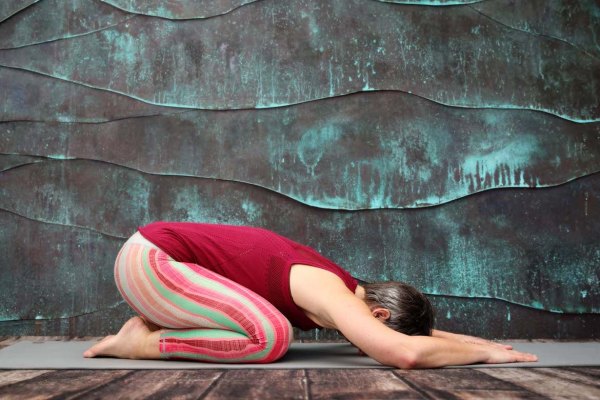
- Begin on your hands and knees in tabletop position and take a deep breath in.
- Exhale and sink your hips back onto your heels, spreading your knees wide enough apart to fit your torso between your thighs.
- Inhale and reach your arms forward to lengthen your spine.
- Exhale and relax your entire body down into the floor.
3. Supported corpse pose (Savasana)
Supported corpse pose “calms the nervous system and provides a reset that can help with hot flashes,” Wyland says.
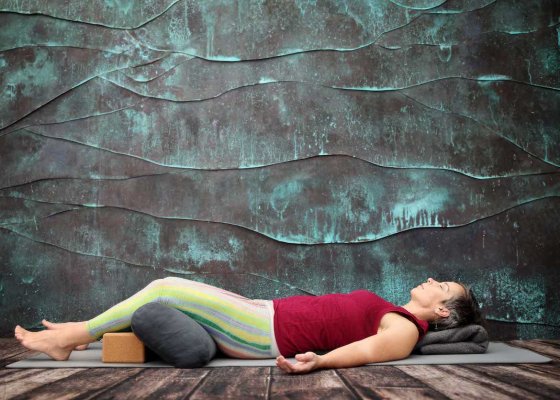
- Lie on your back with your arms out to the side and legs comfortably apart.
- Place a bolster, yoga block, or pillow underneath your legs where it feels most comfortable and place a blanket underneath your head.
- Relax and breathe for as long as you need.
- To come out, first bring small movements to your hands and feet. Bend your knees and roll over to one side.
- Rest in this position until you feel ready to sit up. Take a moment to pause before moving.
4. Downward-facing dog (Adho Mukha Svanasana)
Downward-facing dog “builds shoulder strength, releases the hamstrings, and supports the lower back,” Wyland says.
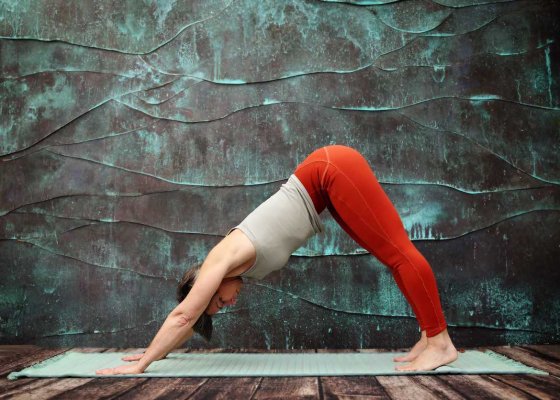
- Start from a tabletop position on your hands and knees with your wrists under your shoulders and your knees under your hips.
- Curl your toes under and press through your hands and toes to lift your knees away from the mat or floor.
- Extend your arms while lifting your hips up and back. Your body should form an inverted “V.”
- Let your head relax naturally toward the ground.
- Keep your knees soft to avoid shifting your weight too far forward.
- Distribute your weight as evenly as possible between your hands and feet.
5. Butterfly pose (Baddha Konasana)
Butterfly pose “brings calm, and stretches your hips and lower back,” Wyland says.
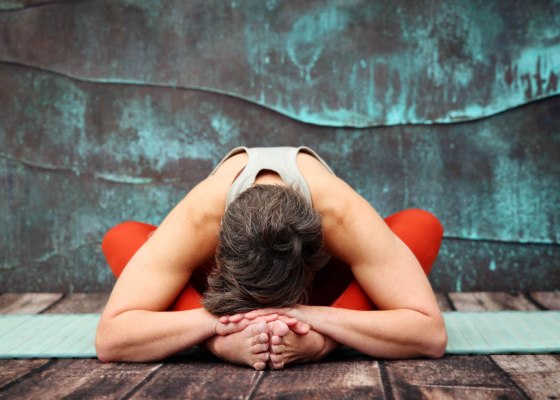
- Sit up tall and bring the soles of your feet together, knees bent and pointing out to the sides.
- Bend your torso until your head meets your feet or bend as far as you comfortably can. You should feel a stretch in your groin, but it shouldn’t be painful.
- Hold for as long as needed, then return to starting position.
Well+Good articles reference scientific, reliable, recent, robust studies to back up the information we share. You can trust us along your wellness journey.
-
Cramer H, Peng W, Lauche R. Yoga for menopausal symptoms-A systematic review and meta-analysis. Maturitas. 2018 Mar;109:13-25. doi: 10.1016/j.maturitas.2017.12.005. Epub 2017 Dec 6. PMID: 29452777. -
Swain D, Nanda P, Das H. Impact of yoga intervention on menopausal symptoms-specific quality of life and changes in hormonal level among menopausal women. J Obstet Gynaecol Res. 2021 Oct;47(10):3669-3676. doi: 10.1111/jog.14939. Epub 2021 Jul 12. PMID: 34254406. -
Avis NE, Legault C, Russell G, Weaver K, Danhauer SC. Pilot study of integral yoga for menopausal hot flashes. Menopause. 2014 Aug;21(8):846-54. doi: 10.1097/GME.0000000000000191. PMID: 24473534; PMCID: PMC4110168. -
Booth-LaForce C, Thurston RC, Taylor MR. A pilot study of a Hatha yoga treatment for menopausal symptoms. Maturitas. 2007 Jul 20;57(3):286-95. doi: 10.1016/j.maturitas.2007.01.012. Epub 2007 Mar 2. PMID: 17336473. -
Susanti HD, Sonko I, Chang PC, Chuang YH, Chung MH. Effects of yoga on menopausal symptoms and sleep quality across menopause statuses: A randomized controlled trial. Nurs Health Sci. 2022 Jun;24(2):368-379. doi: 10.1111/nhs.12931. Epub 2022 Mar 21. PMID: 35191141. -
Afonso RF, Hachul H, Kozasa EH, Oliveira Dde S, Goto V, Rodrigues D, Tufik S, Leite JR. Yoga decreases insomnia in postmenopausal women: a randomized clinical trial. Menopause. 2012 Feb;19(2):186-93. doi: 10.1097/gme.0b013e318228225f. PMID: 22048261. -
Bromberger JT, Epperson CN. Depression During and After the Perimenopause: Impact of Hormones, Genetics, and Environmental Determinants of Disease. Obstet Gynecol Clin North Am. 2018 Dec;45(4):663-678. doi: 10.1016/j.ogc.2018.07.007. Epub 2018 Oct 25. PMID: 30401549; PMCID: PMC6226029. -
Sivaramakrishnan D, Fitzsimons C, Kelly P, Ludwig K, Mutrie N, Saunders DH, Baker G. The effects of yoga compared to active and inactive controls on physical function and health related quality of life in older adults- systematic review and meta-analysis of randomised controlled trials. Int J Behav Nutr Phys Act. 2019 Apr 5;16(1):33. doi: 10.1186/s12966-019-0789-2. PMID: 30953508; PMCID: PMC6451238. -
Woodyard C. Exploring the therapeutic effects of yoga and its ability to increase quality of life. Int J Yoga. 2011 Jul;4(2):49-54. doi: 10.4103/0973-6131.85485. PMID: 22022122; PMCID: PMC3193654. -
Gothe NP, Khan I, Hayes J, Erlenbach E, Damoiseaux JS. Yoga Effects on Brain Health: A Systematic Review of the Current Literature. Brain Plast. 2019 Dec 26;5(1):105-122. doi: 10.3233/BPL-190084. PMID: 31970064; PMCID: PMC6971819.
Our editors independently select these products. Making a purchase through our links may earn Well+Good a commission.
